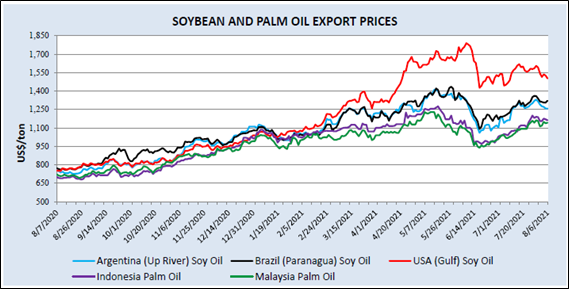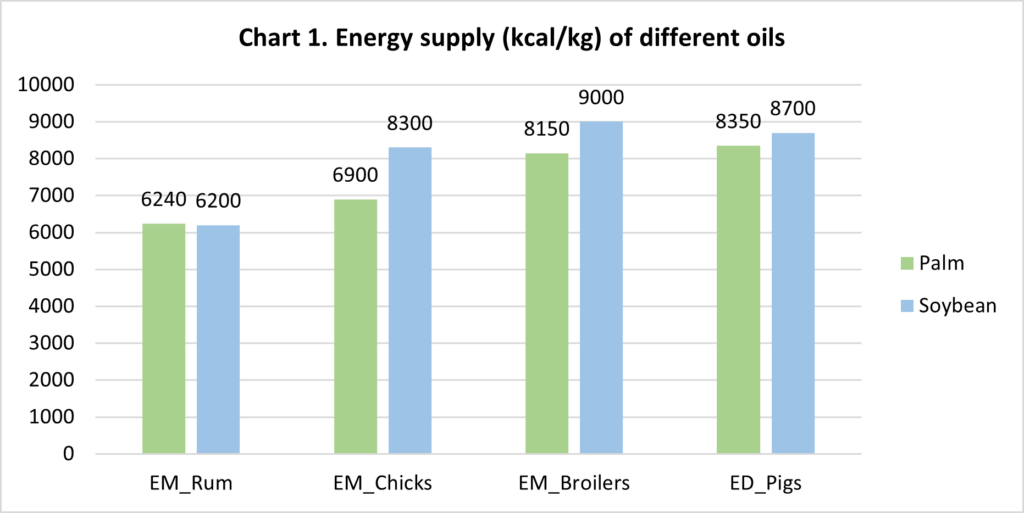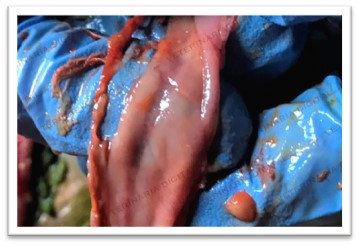Palm oil
Palm oil is a fat of vegetable origin that is in a semi-solid state at room temperature. It comes from the fruits of the African palm (Elaeis guineensis) and is obtained after a thermal and mechanical extraction to separate the crude oil from the pulp of the fruit and eliminate its impurities.
It is the main oil produced worldwide, with 75 million tons per year, followed by soybean oil with 60 million tons per year (USDA 2021b, 2021a).
It has an important role in animal nutrition since it is used as a source of energy and essential fatty acids, such as the linoleic acid, and helps in the absorption of vitamins and other fat-soluble compounds.
Its use in animal feed has increased in the last year, probably due to the marked raise in soybean oil’s price, its main competitor. Although the cost of palm oil is also higher, it has increased to a lesser extent and represents a more affordable option for feed manufactures.
Image 1. Soybean and palm oil export prices in US dollars/ton since the end of 2020

Nutritional properties
Palm oil has a low level of unsaturation, which means that, within the different types of oil, it is one of those that provides the least energy. In fact, the proportion of fatty acids in palm oil is over 80%, with lauric acid being the most abundant. Palm oil is a fat of vegetable origin in a semi-solid state at room temperature. Despite this, it is considered one of the main energy sources in the diet, and it contains high vitamin (vitamin A and E) and fatty acids content.
Table 1. Relation of saturated vs. unsaturated fatty acid on different oils.
| Linseed | Sunflower | Corn | Soybean | Olive | Rapeseed | Palm | |
| Saturated:unsaturated | 0,10 | 0,14 | 0,16 | 0,18 | 0,18 | 0,10 | 0,96 |

Inclusion limits
Inclusion limits are related to the quality of the final product as levels higher than those recommended will lead to excessive fat in the carcass. On the other hand, the high saturation levels of this fat can cause problems during feed manufacturing since it is not in a completely liquid state at room temperature.
Table 2. Maximum inclusion levels (%) for palm oil in poultry and pig feeds. (Blas et al. 2019)

Factors to consider when using palm oil in the diets
Rancidity is one of the most common and worrying problems that occur when using oils. It consists of the oxidative deterioration of lipids through the formation of peroxides and gives rise to the accumulation of products such as aldehydes, ketones and hydrocarbons that cause the loss of quality of raw materials and can damage animal tissues.
Image 2. Enteritis caused by fat acidity.

Unsaturated fatty acids are more prone to oxidation and, although palm oil has a low proportion of polyunsaturated fatty acids (PUFA), of approximately between 7 and 12%, this amount is sufficient to start the peroxidation or rancidity process (Delgado 2004).
Besides, linoleic acid is the main unsaturated fatty acid in palm oil. As it is an essential substance for animals, it is important to prevent the oxidation of the oil to ensure they receive it trhough the diet.
How can we help you?
In Delta Labs, we offer the feed formulation and analysis service to optimize feed composition and adjust it to the requirements of the target species. We can also recommend the most suitable natural antioxidants to prevent problems derived from fat rancidity and oxidation.
We also offer a Diagnostic by Imageservice that includes the evaluation of the problems by a specialized veterinary team and the emission of a report with a presumptive diagnosis and the recommendations to solve the issue.
To use these services, please contact us through our webpage www.globalvetslab.com or email at info@globalvetslab.com
Bibliography
Blas, C. de, P. Carcía-Rebollar, M. Gorrachategui, and G.G. Mateos. 2019. Tablas FEDNA de composición y valor nutritivo de alimentos para la fabricación de piensos compuestos FEDNA (Fundación Española Para El Desarrollo de La Nutrición Animal). 4th ed. Madrid. http://www.fundacionfedna.org/ingredientes-para-piensos.
Delgado, Wilman. 2004. “¿Por Qué Se Enrancian Las Grasas y Aceites?” Palmas 25(42): 35–43. https://publicaciones.fedepalma.org/index.php/palmas/article/view/990%0Ahttp://publicaciones.fedepalma.org/index.php/palmas/article/view/990/990.
USDA. 2021a. “Oilseeds : World Markets and Trade Tight Canada Rapeseed Supplies.” (August).
———. 2021b. Palm Oil 2021 World Production. https://ipad.fas.usda.gov/cropexplorer/cropview/commodityView.aspx?cropid=4243000.
VeterinariaDigital. 2020. “Enteritis Por Acidez de La Grasa.” Atlas de Patología. https://www.veterinariadigital.com/post_blog/enteritis-por-acidez-de-la-grasa/.